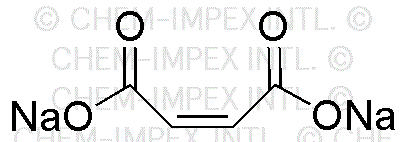Sodium maleate dibasic anhydrous is widely utilized in research focused on:
- Pharmaceutical Formulations: This compound serves as a buffering agent in drug formulations, helping to maintain pH levels, which is crucial for drug stability and efficacy.
- Food Industry: It acts as a food additive, enhancing the texture and stability of various food products, making it valuable for manufacturers looking to improve product quality.
- Textile Industry: Sodium maleate dibasic anhydrous is used in dyeing processes, where it helps in the fixation of dyes on fabrics, leading to vibrant and long-lasting colors.
- Cosmetic Products: This compound is incorporated into cosmetic formulations for its emulsifying properties, allowing for better texture and consistency in creams and lotions.
- Research Applications: In laboratories, it is employed as a reagent in organic synthesis, facilitating various chemical reactions due to its unique properties.
General Information
Properties
Safety and Regulations
Applications
Sodium maleate dibasic anhydrous is widely utilized in research focused on:
- Pharmaceutical Formulations: This compound serves as a buffering agent in drug formulations, helping to maintain pH levels, which is crucial for drug stability and efficacy.
- Food Industry: It acts as a food additive, enhancing the texture and stability of various food products, making it valuable for manufacturers looking to improve product quality.
- Textile Industry: Sodium maleate dibasic anhydrous is used in dyeing processes, where it helps in the fixation of dyes on fabrics, leading to vibrant and long-lasting colors.
- Cosmetic Products: This compound is incorporated into cosmetic formulations for its emulsifying properties, allowing for better texture and consistency in creams and lotions.
- Research Applications: In laboratories, it is employed as a reagent in organic synthesis, facilitating various chemical reactions due to its unique properties.
Documents
Safety Data Sheets (SDS)
The SDS provides comprehensive safety information on handling, storage, and disposal of the product.
Product Specification (PS)
The PS provides a comprehensive breakdown of the product’s properties, including chemical composition, physical state, purity, and storage requirements. It also details acceptable quality ranges and the product's intended applications.
Certificates of Analysis (COA)
Search for Certificates of Analysis (COA) by entering the products Lot Number. Lot and Batch Numbers can be found on a product’s label following the words ‘Lot’ or ‘Batch’.
*Catalog Number
*Lot Number
Certificates Of Origin (COO)
This COO confirms the country where the product was manufactured, and also details the materials and components used in it and whether it is derived from natural, synthetic, or other specific sources. This certificate may be required for customs, trade, and regulatory compliance.
*Catalog Number
*Lot Number
Safety Data Sheets (SDS)
The SDS provides comprehensive safety information on handling, storage, and disposal of the product.
DownloadProduct Specification (PS)
The PS provides a comprehensive breakdown of the product’s properties, including chemical composition, physical state, purity, and storage requirements. It also details acceptable quality ranges and the product's intended applications.
DownloadCertificates of Analysis (COA)
Search for Certificates of Analysis (COA) by entering the products Lot Number. Lot and Batch Numbers can be found on a product’s label following the words ‘Lot’ or ‘Batch’.
*Catalog Number
*Lot Number
Certificates Of Origin (COO)
This COO confirms the country where the product was manufactured, and also details the materials and components used in it and whether it is derived from natural, synthetic, or other specific sources. This certificate may be required for customs, trade, and regulatory compliance.

